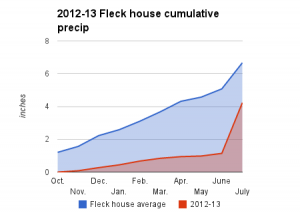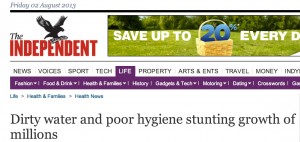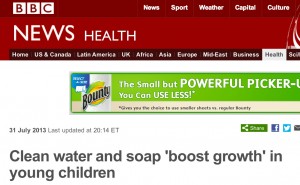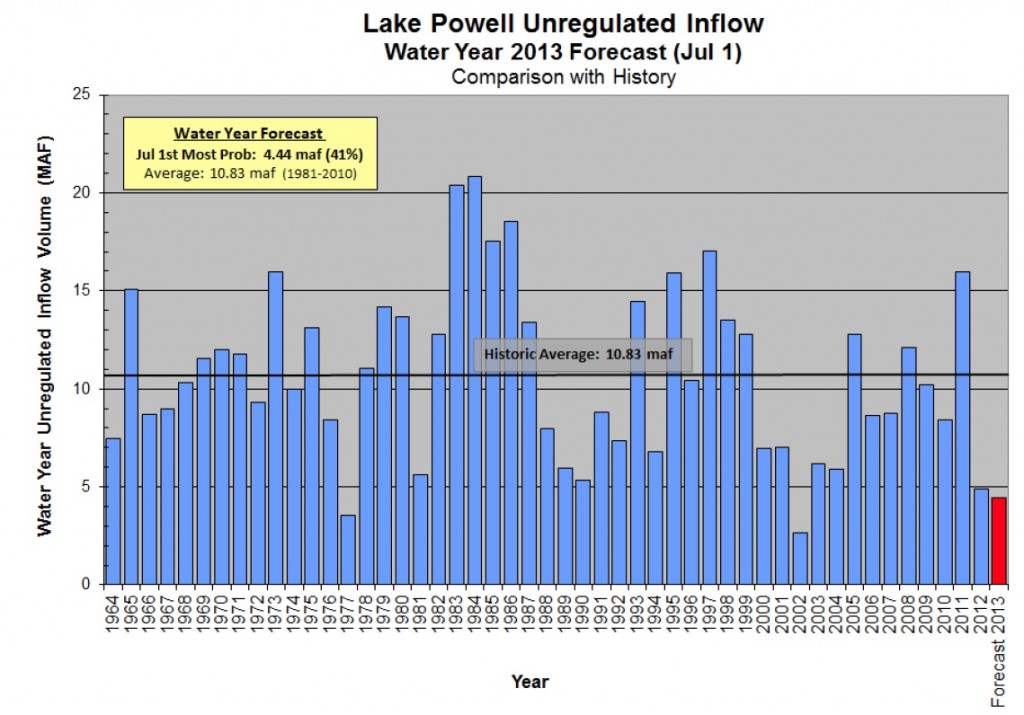stuff I’ll talk about elsewhere on the radio
I’ll be on the radio Saturday at 9 a.m. with Katie Stone on KUNM’s Children’s Hour (one of the great Albuquerque media institutions) explaining Albuquerque’s aquifer. Streaming live on line or on your mobile device.
Colorado Basin – the demand side problem
From Jay Lund, a comment on my post last week about low flows into that is worth elevating:
Perhaps a bigger issue is that average unimpaired flow appears to be < 11 maf, but total allocations are more than 16 maf/year (1.5 maf/yr for Mexico and 7.5 maf each for the upper-basin and lower-basin states). Mexico and the lower basin states already use their full allocations. As upper basin state use grows, water storage in the amazingly large Colorado R. reservoirs will diminish over time. We will blame droughts and climate change, but overallocation is a more than equal contributor to the problem. Improving allocations will have large economic benefits.
July rain: what a difference a month makes
I got what may be my all time favorite reader comment a couple of weeks back when I tried to explain that the summer rains New Mexico has been getting do not mean our drought is over:
This article is miserablism at its absolute worst. How about looking at important progress in reservoirs like Conchas where water levels are up 6 feet – during the summer months? It’s pretty obvious you don’t reverse a ten year drought in a month, but looking at Elephant Butte and concluding nothing beneficial has occurred, when the rainwater hasn’t even made it that far yet, is just Fleck being his usual dismal self. If you don’t like living in a desert, why don’t you move??
I must admit I was a little worried when it started raining the first week in July. But once I realized I could write about storms ruining alfalfa and flooding neighborhoods and twist the knife with the “but the drought’s not over!” taunt, I knew I was golden. This is a once-in-a lifetime journalistic opportunity. Fleck the Miserablist, at your service.*
I loved the comment so much, I wrote the same story a week later, but my trolling failed.**
We got 3.09 inches (7.8 cm) of rain at our Albuquerque house in July. That’s our wettest month since August 2008. Still just 63 percent of average for the water year, but much better than it was.
* This paragraph is a joke. Its purpose is to poke fun at me and my profession, incentivized, as Danah Boyd argues, by fear and the attention economy.
** This paragraph also is a joke. I wrote the second story because the drought really is serious, and all available evidence suggests the rains have helped little, and public understanding seems an important thing. Plus fear economy.
cheap water
The cheapest source of new water is being less wasteful with old water.
“Sir: You have made me unhappy”
From a letter to Franz Kafka:
Sir,
You have made me unhappy. I bought your ‘Metamorphosis’ as a present for my cousin, but she doesn’t know what to make of the story.
As quoted in the Economist’s review of Kafka: The Years of Insight.
Framing clean water and kids – is the glass half dirty or half clean?
The Independent – Dirty water and poor hygiene stunting growth of millions:
The BBC – Clean water and soap ‘boost growth’ in young children:
Fourteen years of Colorado River Basin drought
Here’s a striking graph distributed this week at the U.S. Bureau of Reclamation’s 2014 Colorado River Annual Operating Plan consultation meeting in Las Vegas:
That’s annual unregulated* inflow into Lake Powell on the Colorado River. A couple of things worth noting:
- 2012 and 2013 are two of only four years since Glen Canyon Dam was completed with inflows less than 5 million acre feet
- Only three of the 14 years from 2000 to the present have had above average inflows into Lake Powell
- Three of the four lowest years on record have occurred during the current drought
This data isn’t new, it was just striking to me to see this graphical representation.
* “unregulated inflow” involves an estimate of what the natural inflow into Lake Powell would have been absent upstream dams and diversions
Mike Taugher, a journalist’s journalist
Amid some tears today over the tragic death of my former colleague Mike Taugher, I found a couple of stories he wrote about California water worth sharing. Mike was the Albuquerque Journal’s environment beat reporter back in the 1990s, and a nicer colleague you couldn’t have found, a talent, a joy to work with, a mensch.
He’d moved on to California, where from his perch at the Contra Costa Times he’d become one of the most useful and productive reporters covering California water before he left the business last year to go to work for state government.
Here’s a great example of his work, bird-dogging the connections between billionaire “farm baron” Stewart Resnick and Sen. Dianne Feinstein:
Acting at the request of Beverly Hills billionaire and Kern County water baron Stewart Resnick, U.S. Sen. Dianne Feinstein is seeking a high-level scientific review of new endangered-species permits that farmers and others blame for water shortages.
It’s juicy stuff, an admirable example of a dogged journalist trying to hold power accountable on behalf of the people. It’s easy to understand why that sort of journalism matters, and it’s the kind of work upon which we often heap praise.
Here’s an entirely different sort of piece, this about the endangered Delta smelt:
[W]hy should anyone care if a nondescript little fish goes the way of the dodo?
After all, Delta smelt do not make the A-Team of endangered species, the so-called charismatic megafauna — bald eagles, grizzly bears, otters, whooping cranes and the like — that people tend to want to protect, if only because they look magnificent in magazines and nice on neckties.
This is not the sort of flashy investigative work that wins plaudits (of which Mike had won many). This was explanatory journalism at the top of its craft, a deft piece of work helping us make sense of our world.
That Mike could do both things so well (and with a cheerful modesty that was a delight to be around) is why he was a journalist’s journalist.
the irrigation efficiency dilemma
In the arid west, increased irrigation efficiency is one of the most commonly suggested solutions to our water problems. But Jay Lund and Thomas Harter point out the dilemma:
In many areas, drought-year groundwater supplies depend substantially on irrigation inefficiency in wetter years, when surface water is available and used by farmers. Ironically, local inefficiency often improves regional water use efficiency and sustainability. However, excessive groundwater pumping causes long-term continual decline in groundwater levels (“overdraft”) and irrigation inefficiency increases salt and nitrate loads to groundwater. There are few perfect solutions in water.
Mixed bag.





